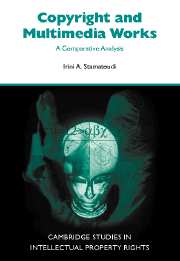Book contents
- Frontmatter
- Contents
- Acknowledgments
- List of abbreviations
- Introduction
- 1 Placing multimedia products within the scope of copyright
- 2 The scope of multimedia works
- 3 Traditional literary works
- 4 Collections and compilations
- 5 Databases
- 6 Audiovisual works
- 7 Computer programs
- 8 Video games as a test case
- 9 Multimedia products and existing categories of copyright works
- 10 A regime of protection for multimedia products
- 11 Conclusions
- Postscript
- Bibliography
- Index
6 - Audiovisual works
Published online by Cambridge University Press: 25 July 2009
- Frontmatter
- Contents
- Acknowledgments
- List of abbreviations
- Introduction
- 1 Placing multimedia products within the scope of copyright
- 2 The scope of multimedia works
- 3 Traditional literary works
- 4 Collections and compilations
- 5 Databases
- 6 Audiovisual works
- 7 Computer programs
- 8 Video games as a test case
- 9 Multimedia products and existing categories of copyright works
- 10 A regime of protection for multimedia products
- 11 Conclusions
- Postscript
- Bibliography
- Index
Summary
Unless multimedia works are projected onto a screen, their contents cannot be read, accessed or manipulated by users. The experience of copyright lawyers and others to date shows that there is, arguably at least, a strong presumption that data including, or mainly composed of, sound and images, which are projected onto a screen, falls within the category of audiovisual works. Thus, if we were to judge multimedia works according to their appearance or looks alone, we could argue that the one category of protection which seems most capable of accommodating multimedia products is that of audiovisual works.
This chapter will examine whether this initial presumption corresponds to the actual characteristics and needs of multimedia works when the issue is considered in detail. It will also consider whether the inclusion of elements of image and sound in a multimedia work is enough to place it under the legal umbrella of audiovisual works or related categories such as cinematographic works, films or motion pictures.
‘AUDIOVISUAL WORKS’ AS A GENERIC TERM
Audiovisual works
Not all national jurisdictions contain a definition of audiovisual works in their copyright laws. However, the French Copyright Act, in article L112-6, defines audiovisual works as ‘works consisting of sequences of moving images, with or without sound’. From this definition it can be seen that an audiovisual work cannot exist unless a ‘sequence of moving images’ is not only present but also prevalent. This is the criterion for the existence of an audiovisual work.
- Type
- Chapter
- Information
- Copyright and Multimedia ProductsA Comparative Analysis, pp. 104 - 151Publisher: Cambridge University PressPrint publication year: 2001



